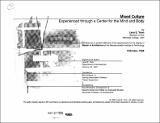Mixed culture : experienced through a center for the mind and body
Author(s)
Yoon, Lana E. (Lana Eunjoo), 1972-
DownloadFull printable version (20.90Mb)
Other Contributors
Massachusetts Institute of Technology. Dept. of Architecture.
Advisor
Bill Hubbard, Jr.
Terms of use
Metadata
Show full item recordAbstract
The term "Mixed Culture" refers to the sociological condition experienced by those who have a cultural heritage which is different from the culture in which they were raised or live in. In this mixture, there are characteristics from either that remain distinct, yet coexist. I identify myself and my culture as an American, but I was also raised with and practice certain traditional Korean customs which were passed down to me by family. I find that I am constantly moving between two states, where I identify with either of my two cultures, sometimes distinctly separate or at other times both concurrently. This constant moving between two different states or cultures, as well as being able to simultaneously identify with two different positions describes the experience of being part of a mixed culture. This thesis takes these definitions and sociological characteristics as the starting point to defining Asian American architecture. Instead of continuing to base Asian American architecture on applied decorations, the architecture will draw upon the spatial characteristics found in traditional architectural examples, as well as juxtapose different elements within one building. This center and hotel has three components: a health center offering instruction and treatments based upon East Asian medicinal practices such as acupuncture, herbal pharmacology, massage, yoga, and tai chi, a tea cafe for service to the street and a small hotel whose residents will be registered users of the center from outside of the Bay Area. In addition to the architectural elements and the program, the site, located in between Nob Hill and the historic core of Chinatown in San Francisco, California, acts as another arena to address the mixing between two different neighborhoods.
Description
Thesis (M. Arch.)--Massachusetts Institute of Technology, Dept. of Architecture, 1998. Includes bibliographical references (p. 87-89).
Date issued
1998Department
Massachusetts Institute of Technology. Department of ArchitecturePublisher
Massachusetts Institute of Technology
Keywords
Architecture.